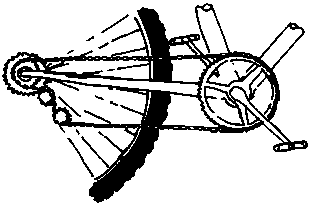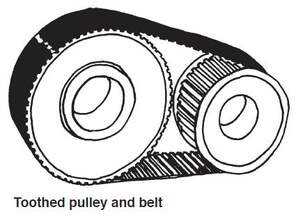|
"THE POWER OF THE PULLEY
Pulleys work in a similar way to gears except they are not directly joined but linked by either elastic bands, tubular springs or some other flexible but strong material which is referred to as a belt. A common example is the fan belt in a car that links a number of pulleys. To stop the pulley belt slipping over the edge they have grooves in them. This keeps the belt running in a straight line and stops it from 'Jumping off'. Pulleys that use some form of belt drive are referred to as a “Friction Drive” mechanism. |
Pulleys have several advantages over gears but also some disadvantages.
The main advantage is the fact that they are simple to make and can be used at a distance from each other unlike gears that need to touch in order to work. The disadvantage is that they work by friction and so can slip. This could seriously upset the timing of a complex Automata. You can get a toothed pulley and belt which eliminates any slipping or timing problems. Many cars have a cam belt that works on this principle. Some model suppliers sell special toothed pulleys but they tend to be very expensive and aren't often used for Automata which generally use a “ Friction Belt” system. This is simple and very effective in most cases. The belt can be substituted for a chain. A bicycle is a good example of this principle. Model supplier often stock small plastic toothed pulleys or chain sets which are reasonably priced. |
|
Like gears, you can use the pulley to either step up or step down the drive. But instead of counting teeth as with gears you, simply make the diameter of the pulley wheels larger or smaller. By dividing the input diameter by that of the output, you can work out a final ratio. In the above example, the ratio is 2:1. This means for every 2 revolutions of the input pulley the output turns one full revolution. You could of course reverse this around.
You may have noticed that pulleys rotate in the same direction (unlike gears which do the opposite). |
|
APPLYING PULLEYS TO AUTOMATA
When you want to transmit the drive over some distance, then pulleys are an ideal choice. As we have seen, they are simple to construct and take up comparatively little space. In fact they share many of the virtues of the ratchet with the big advantage of producing a constant and smooth drive force. But it doesn’t stop there, the pulley can perform one other vital function and that is to change the direction of drive. This can be to any angle but the most common use would be to turn the drive through 90 degrees. This same task could be performed by gears but would be significantly more difficult to make. When It comes to making Automata, this simple trick of changing the drive direction can be invaluable for its simplicity and effectiveness. |









